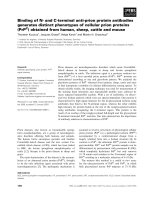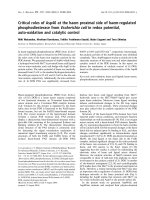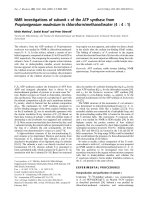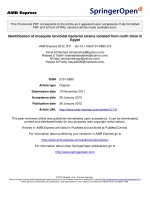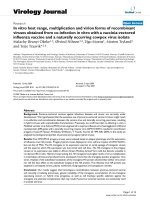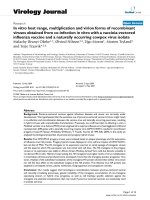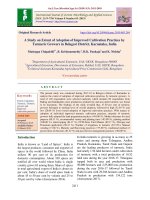Antibiogram of bacterial isolates obtained from milk samples in and Around Hyderabad, India
Bạn đang xem bản rút gọn của tài liệu. Xem và tải ngay bản đầy đủ của tài liệu tại đây (168.06 KB, 5 trang )
Int.J.Curr.Microbiol.App.Sci (2018) 7(3): 3720-3724
International Journal of Current Microbiology and Applied Sciences
ISSN: 2319-7706 Volume 7 Number 03 (2018)
Journal homepage:
Original Research Article
/>
Antibiogram of Bacterial Isolates Obtained from Milk Samples in and
Around Hyderabad, India
Shiva Jyothi1, Kalyani Putty1, R.N. Ramani Pushpa2, Hannan Umair1, Amol3,
Vijay Muley3, K. Dhanalakshmi1 and Y. Narasimha Reddy1*
1
College of Veterinary Science, P. V. N. R. Telangana Veterinary University, Rajendrangar,
Hyderabad-500030, Telangana, India
2
NTR College of Veterinary science Gannavaram, India
3
Zoetis, Mumbai, India
*Corresponding author
ABSTRACT
Keywords
Bacterial isolates,
Mastitis, Antibiotic
sensitivity test,
Ceftiofur
Article Info
Accepted:
28 February 2018
Available Online:
10 March 2018
The present study was undertaken to estimate the prevalence of bacterial pathogens in milk
samples and to assess the antibiotic sensitivity pattern of the causative organisms in and
around Hyderabad region of Telangana state, India. A total of 1143 milk samples were
collected from cross bred dry cows from in and around Hyderabad region, and were
subjected to bacteriological studies and in-vitro antibiotic sensitivity test. Out of 1143
samples, a total of 1168 bacterial isolates were obtained of which Staphylococcus sp. was
found to be the most predominant followed by E. coli, Streptococci spp, and Pseudomonas
spp. Antibiogram studies showed maximum sensitivity to ceftiofur with 60% for
Staphylococcus sp. and Pseudomonas species, 58% for Streptococcus sp. and 90% for E.
coli that were isolated in the current study. Hence, the probable use of Ceftiofur as a
potential antimicrobial (preferably for mastitis) in the tested geographic region was
proposed from the findings of the current study.
Introduction
Mastitis has long been recognized as one of
the economically important diseases affecting
dairy cows and a major cause of economic
loss to Indian dairy industry (Sasidhar et al.,
2002). This condition is characterized by
physical and chemical changes in the milk and
pathological changes in the glandular tissue
(Blood and Radostits, 1989). Overall losses
due to mastitis in India were estimated to be
Rs.7165.51 crores (Bansal and Gupta, 2009).
Mastitis is also the most important reason for
culling of cows in the dairy industry (Barkema
et al., 1999). The sub clinical form of mastitis
in dairy cows is important because it is 15-40
times more prevalent than the clinical form,
reduces the milk production and adversely
affects the milk quality (Seegers et al., 2003).
Staphylococcus is the major etiological agent,
followed by Streptococcus and E. coli causing
subclinical mastitis in cows in India (Singh
and Baxi, 1982). Since bacteria are the major
etiological agents of mastitis, indiscriminate
use of antibiotics without in vitro testing may
lead to treatment failure and also results in
3720
Int.J.Curr.Microbiol.App.Sci (2018) 7(3): 3720-3724
development of resistance to antimicrobials.
Identification of mastitis causing pathogens
and identification of the antibiotic resistance
pattern of the isolated bacteria are important
prerequisites for implementation of effective
treatment of mastitis. This information is
needed not only to treat and control mastitis
but also to address public health concerns
(Dhakal et al., 2007). Rapidly-evolving
Antimicrobial Resistance is a global concern
to human health and food supply chain
(Cosgrove and Carmeli, 2014). Hence the
present study was conducted to isolate and
identify the bacteria from milk samples and to
study the antibiotic resistance pattern of
isolates. To our knowledge, the present study
is the first retrospective study that investigated
the susceptibility patterns of pathogens
isolated from dairy cows in India to Ceftiofur.
Materials and Methods
A total of 1143 milk samples were collected
from crossbred dairy cows and processed for
isolation of bacteria and their antibiogram was
performed. Milk samples were centrifuged at
2000 g at 37C for 10 minutes, supernatant
was discarded, 5 ml of BHI broth was added
to the sediment and incubated at 37C for 24 h
(Cruickshank et al., 1975). For isolation of
Streptococci, 0.9 ml of Streptococci Selective
Broth (SSB) was inoculated with 0.1 ml of
milk sample and incubated at room
temperature in anaerobic jar for 24 h. After
incubation of milk samples in SSB, the broth
was examined for the presence of
Streptococcal
organisms
and
further
inoculated on to Edwards’s medium. After
incubation of milk samples in BHI broth the
morphology of the organisms was studied with
Gram’s stain and cultural characters of the
isolates was studied using different media
such as Nutrient agar, Mac Conkey agar,
Edward’s medium, Eosin Methylene Blue agar
(EMB), and Manitol Salt Agar (MSA). The
isolates were also subjected to various
biochemical tests as per the methods described
by Cruickshank et al., (1975) and Bailey and
Scott’s (2007). Antibiogram was studied by
using Antibiotic test discs manufactured by
Hi-media Laboratories limited, Mumbai and
Oxoid, UK with principle of disc diffusion
method of Kirby and Baeur as described by
Cruickshank et al., (1975). The antibiotics and
their concentration used in the present study
are Ampicillin (10µg), Ceftiofur (30µg),
Ceftrioxone (30µg), Enrofloxacin (30µg)
Gentamicin (30µg), Methicillin (30µg), and
Tetracycline (30µg). The interpretations of test
were carried out according to CLSI guidelines
(2013).
Results and Discussion
A total of 1168 isolates were cultured from the
milk samples, of which Staphylococcus sp.
(62.9%) was predominant followed by E. coli
(24.4%), Streptococcus sp. (8.3%), and
Pseudomonas sp. (4.4%) (Fig. 1). The in-vitro
antibiotic resistance pattern performed for the
isolated organisms-Staphylococcus species, E.
coli, Streptococcus sp and Pseudomonas sp.
revealed that Staphylococci sp. showed
highest percentage of resistance to methicillin
(82.5%) and least to ceftiofur (40%). Most of
the E.coli isolates were resistant to ampicillin
(61.5%) and minimum resistance was
observed with ceftiofur (12%). Streptococcus
sp. isolates in the study showed maximum
resistance to ceftrioxone (60%) and minimum
to ceftiofur (3%). Pseudomonas isolates
revealed maximum resistance to ampicillin
(58%) and minimum to ceftiofur (29%).
The present study showed that Staphylococcus
sp. was the predominant pathogen isolated
followed by E. coli, Streptococcus sp. and
Pseudomonas sp. For Staphylococcus isolates
(735), among the drugs tested, ceftiofur was
most sensitive showing 60% sensitivity,
followed by tetracycline (42%), gentamicin
(37.5%), enrofloxacin (34%), ampicillin
3721
Int.J.Curr.Microbiol.App.Sci (2018) 7(3): 3720-3724
(18%) and methicillin (17.5%). The sensitivity
pattern of Streptococcus isolates (97) showed
highest sensitivity for ceftiofur (68%),
followed by enrofloxacin (50%), gentamicin
(48%), tetaracycline (46%), ampicillin (40%),
and ceftrioxone (40%). E. coli isolates (284)
showed highest sensitivity to ceftiofur (88%)
followed by enrofloxacin (76%), ceftriaxone
(75%), tetracycline (70%), gentamicin (68%),
and ampicillin (38%). Pseudomonas isolates
(52) showed highest sensitivity to ceftiofur
(71%) followed by ceftriaxone (69%),
gentamicin (58%), tetracycline (52%),
enrofloxacin (50%), and ampicillin (42%)
(Fig. 2). Alekish et al., (2013) studies showed
that the most prevalent pathogens isolated
were Staphylococcus aureus (53.4%), E. coli
(16 %), Streptococcus non-agalactiea (5.9%),
and coagulase negative Staphylococci (CNS)
(5.9%). The antibiotics for which, most of the
isolated pathogens were sensitive to were
enrofloxacin (61.2%) and ciprofloxacin
(58.7%). While the ones that the pathogens
were
mostly resistant
against
were
sulfa/trimethoprim (87.4%), and penicillin
(84.5%). Samad Mosaferi et al., (2015)
reported that the results of antibiotic
susceptibility testing for samples isolated from
mastitis in the dry period showed most
sensitivity to enrofloxacin and tetracycline and
least sensitivity to ampicillin and penicillin.
However, Sumathi et al., (2008) reported that
gentamicin was the most effective drug for
Staphylococcus, E. coli, Streptococcus and
Klebsiella. While Jeykumar et al., (2012)
reported that mastitis pathogens were highly
resistant to penicillin G and sensitive to
enrofloxacin, Nadeem et al., 2013) reported
that enrofloxacin was the effective drug
followed by norfloxacin and gentamicin. Bhatt
(2011) reported that Staphylococcus aureus
and Pseudomonas evinced highest resistance
to penicillin G and oxacillin antibiotics. The
cause of differences among the results of the
conducted studies might be due to
indiscriminate and frequent use of antibiotics
along with the variation in the type of drugs
most commonly used in a particular area. The
major reason that attribute to high sensitivity
to Ceftiofur may be that they are not yet used
in dairy cows and are relatively expensive.
Their high cost and being not been used means
these drugs have not been misused and hence
are more effective compared to those that have
been in use for quite a long time. The
resistance of the isolates to the antibiotics
including ceftiofur in the current study to
some extent could also be due to biofilm
formation
by
the
pathogens
tested
(unpublished data) which could be reduced by
the use of antibiofilm agents in combination
with the antibiotics.
Fig.1 Prevalence of bacteria isolated from milk samples
The profile showing prevalence of organisms the highest being Staphylococcus spp (62.9%), followed by E. coli
(24.4%), Streptococci spp (8.3%), and Pseudomonas spp (4.4%).
3722
Int.J.Curr.Microbiol.App.Sci (2018) 7(3): 3720-3724
Fig.2 In-vitro Antimicrobial susceptibility test results of all milk bacterial isolates
Staphylococcus isolates (735), showed highest sensitivity to ceftiofur 60%, followed by tetracycline (42%),
gentamicin (37.5%), enrofloxacin (34%), ampicillin (18%) and methicillin (17.5%). E. coli isolates (284) showed
highest sensitivity to ceftiofur (88%) followed by enrofloxacin (76%), ceftriaxone (75%), tetracycline (70%),
gentamicin (68%), and ampicillin (38%). For Streptococcus isolates (97) showed highest sensitivity for ceftiofur
(68%), followed by enrofloxacin (50%), gentamicin (48%), tetaracycline (46%), ampicillin (40%), and ceftrioxone
(40%). Pseudomonas isolates (52) showed highest sensitivity to ceftiofur (71%) followed by ceftriaxone (69%),
gentamicin (58%), tetracycline (52%), enrofloxacin (50%), and ampicillin (42%).
Regular screening of cultures for susceptibility
pattern will be highly useful for selecting an
appropriate antibiotic and also to know the
changing trends of antibiotic resistance for
developing antibiotic usage policy and for
limiting the indiscriminate use of powerful
antibiotics like cephalosporin as initial
treatment.
In addition, awareness among farmers and
clinicians for reducing the unnecessary use of
antimicrobial
drugs
may
restrict
the
development of multidrug resistance pattern.
As mastitis is a major cause of antibiotic use in
dairy animals, early diagnosis, establishment of
correct in-vitro antibiogram along with proper
food and hygiene status of animal is very much
essential to control mastitis and to prevent the
spread of resistant clones of bacteria to other
susceptible animals.
Conflict of interest
The authors declare that they have no
competing interests.
Acknowledgements
We are thankful to all the farm owners who
alerted us of and assisted us in the collection of
milk samples. This work was supported by
Zoetis, Mumbai, India, Department of
Veterinary Microbiology and Department of
Veterinary
Biotechnology.
College
of
Veterinary Science Rajendranagar Hyderabad.
References
Alekish M. O, Al-quda K M, Al-saleh A
Prevalence of antimicrobial resistance
among bacterial pathogens isolated from
bovine mastitis in northern Jordan. Revue
Méd. Vét., 2013, 164, 6, 319-326.
3723
Int.J.Curr.Microbiol.App.Sci (2018) 7(3): 3720-3724
Bailey and Scott's Diagnostic Microbiology
12th Edition Betty A. Forbes, Daniel F.
Sahm, and Alice S. Weissfeld.
Bansal, B.K., Gupta, D.K. 2009. Economic
analysis of bovine mastitis in India and
PunjabA review. Indian J Dairy Sci. 67:
337-45.
Barkema, H.W., Deluyker, H.A., Schukken,
Y.H. and Lam, T.J.G.M. 1999. Quartermilk somatic cell count at calving and at
the first six milkings after calving. Prev.
Vet. Med. 38: 1-9.
Bhatt, V.D, Patel, M.S., Joshi, C.G., Kunjadia,
A. 2011. Identification and antibiogram
of microbes associated with bovine
mastitis. Anim Biotechnology. 22(3): 1639.
Blood, D.C. and Radostits, O.M. 1989.
Veterinary Medicine: A Textbook of the
Diseases of Cattle, Sheep, Pigs, Goats and
Horses, 7th ed., 501.
Clinical and Laboratory Standards Institute
Document M100-S23. Vol 33, No. 1.
USA. Wayn PA. 2013. Performance
standards for antimicrobial susceptibility
testing:
twenty
first
information
supplement.
Cosgrove, S. E. & Carmeli, Y. The impact of
antimicrobial resistance on health and
economic outcomes. Clin. Infect. Dis.
1433(36), 1433–7 (2014)
Cruickshank, R., Duguid, J.P., Marmion, B.P.
and Swain, R.H.A. 1975. Medical
Microbiology.12th edn. Vol. II, Churchill
Livingstone, London.
Dhakal, I.P, Koshihara, T and Nagahata, H.
2007.
Epidemiological
and
bacteriological survey of buffalo mastitis
in Nepal. J.Vet. Med. Sci. 69; 1241-1245.
Jeykumar, M., Vinodkumar, G., Bimal, P.,
Bashir
and
Krovvid,
S.
2013.
Antibiogram of mastitis pathogens in the
milk of crossbred cows in Namakkal
district, Tamil Nadu. Vetworld.354-356.
Nadeem akram, Azhar h. Chaudhary, Shabbir
ahmed, Manzoor a. Ghuman, Ghazala
nawaz, Sajjad hussain. 2013. Isolation of
bacteria from mastitis affected bovine
milk and their antibiogram. European
Journal of Veterinary Medicine, no. 1,
38-46
Samad Mosaferi, Reza Ghabouli Mehrabani,
Mansoor Khakpoor, Nader Ghabouli
Mehrabani4, Amir Maleksabet, Faezeh.
Prevalence of bacterial agents isolated
from clinical cases of bovine mastitis in
the dry period and the determination of
their antibiotic sensitivity in Tabriz, Iran
Hamidi. Journal of Coastal Life Medicine
2015; 3(9): 701-703
Sasidhar P V K, Ramana Reddy Y and
Sudhakar rao G V 2002 Economics of
mastitis, India Journal of Veterinary
Science 72 (6): 439-440.
Seegers, H., Fourichon, C and Beaudeau, F.
2003. Production effects related to
mastitis and mastitis economics in dairy
cattle herds. Veterinary Research. 34:
475-491
Singh, K. B. and K. K. Baxi. 1982. Studies on
the etiology in vitro sensitivity and
treatment of subclinical mastitis in milch
animals. Indian Veterinary Journal.
59:191-198.
Sumathi, B.R., Veeregowda, B.M. and Gomes,
A.R. 2008. Prevalence and antimicrobial
profile of bacterial isolates from clinical
bovine mastitis. Vet. World. 1: 237-238.
Vinod Kumar. N, Sudheer Babu.G, Lahari. L,
Radhika. B and Karthik. A. Antibiogram
of Pathogens of Mastitis from Chittoor
District: Andhra Pradesh. Indian Vet. J.,
August 2016, 93 (08): 66 – 68
How to cite this article:
Shiva Jyothi, Kalyani Putty, R.N. Ramani Pushpa, Hannan Umair, Amol, Vijay Muley, K.
Dhanalakshmi and Narasimha Reddy, Y. 2018. Antibiogram of Bacterial Isolates Obtained from
Milk Samples in and around Hyderabad, India. Int.J.Curr.Microbiol.App.Sci. 7(03): 3720-3724.
doi: />
3724
